
* The Douglas DC-3 was a landmark of aviation design when it was introduced in the mid-1930s, and in its C-47 military form it would be one of the major tools of the Allied war effort. It would have a significant postwar career, and in fact is still flying in some numbers in the 21st century.
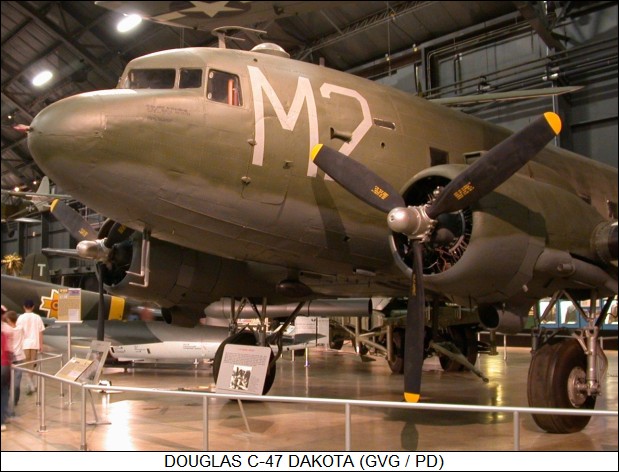
* In the early 1930s, Boeing introduced a landmark aircraft, the Boeing "Model 247", that did much to advance the state of the art of commercial airliner technology. The Boeing 247 entered service with United Air Lines. In 1932 Trans World Airways (TWA), bumped by Boeing to second priority behind United for delivery of Model 247s, contacted Douglas Aircraft to obtain a comparable airliner.
Donald Douglas SR put his crew to work on the project, and on 1 July 1933 the "DC-1 (Douglas Commercial 1)" took to the air for the first time. The DC-1 was a low-wing monoplane, with a capacity of 12 passengers, and twin Wright Cyclone R-1820 nine-cylinder air-cooled radial engines driving three-bladed propellers. The TWA request had specified three engines, but Douglas managed to convince TWA's technical adviser, Charles Lindberg, that two would do the job.
The DC-1 was an all-metal aircraft, except for some fabric-covered control surfaces, with taildragger landing gear -- the main gear partially retracting forward into the engine nacelles, and a nonretractable tailwheel. It was effectively a prototype and only one was ever built. It was used by TWA for promotional flights and eventually ended its days in Spain.
The production aircraft was the "DC-2". It had the same general configuration as the DC-1, but it was stretched to carry 14 passengers and had more powerful Cyclone engines. It also added rubber pneumatic de-icing boots to the leading edges of all flight surfaces. TWA ordered an initial batch of 25 DC-2s. The DC-2 first flew on 11 May 1934, and entered TWA service a week later. It proved to be a popular aircraft, with several hundred built in all, and laid the groundwork for a derivative that would become truly famous -- one that would reduce the groundbreaking Boeing Model 247 to relative obscurity.
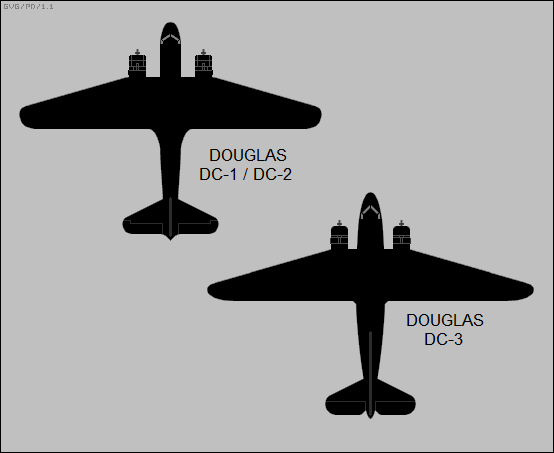
* In 1934, American Airlines (AA) was considering a US transcontinental air service. Given the flight speeds of the time that implied passenger sleeping facilities on the aircraft, and so AA asked Douglas to build an enlarged version of the DC-2 that could accommodate sleeping berths.
Douglas was scrambling to meet orders for the DC-2 at the time and was reluctant to move off in another direction, but the company took the contract. Douglas developed a new version of the DC-2 that had greater wingspan, a larger tail, longer fuselage, and fuselage width increased by 66 centimeters (26 inches). The new aircraft could accommodate 16 sleeping berths or 28 seats. Fitted with berths, it was known as the "Douglas Sleeper Transport (DST)"; fitted with seats, it was known as the "DC-3". This document refers to the type as the DC-3 for simplicity, though production totals include some DSTs.
The first DC-3 flew on 17 December 1935, the 32nd anniversary of the Wright Brothers' first powered flight. The first production aircraft was handed over to AA in June 1936 to begin flight services between New York and Chicago. Intercontinental services began in September 1936.
Initial production versions of the DC-3 used Wright R-1820-G5 Cyclone engines with 685 kW (920 HP) each. The DC-3A featured Pratt & Whitney (P&W) R-1830 Twin Wasp radial engines with 746 kW (1,000 HP) each, and the DC-3B featured Wright R-1820-G-102 Cyclones with 820 kW (1,100 HP) each. The DC-3 quickly eclipsed the DC-2. By the time the United States entered World War II in December 1941, 430 DC-3s had been delivered, and that was only the beginning.
BACK_TO_TOP* The US Navy was the first American military service to buy a Douglas Commercial transport, with the Navy purchasing a single DC-2 in 1934 and designating it the "R2D". The service later bought four more DC-2s as "R2D-1s".
In 1936, the US Army Air Corps (USAAC) service ordered a single DC-2 for evaluation purposes. This aircraft was designated "XC-32". The favorable evaluation of the XC-32 led to an order for two "YC-34s", featuring minor changes as specified by the USAAC, and then 18 "C-33s", which had a taller tailfin and a cargo door.
One of the C-33s was refitted with a DC-3 tail for evaluation purposes and redesignated "C-38". This evaluation led to a USAAC order for 35 "C-39s", which featured additional DC-3 components, such as landing gear and uprated Wright R-1820-55 Cyclone engines. The first C-39 went into service in 1939.
A few C-39s were modified to other configurations. One was fitted in production with Pratt & Whitney R-1830-21 Twin Wasps and designated "C-41". Another C-39 was similarly fitted in production with uprated Wright R-1820-53 Cyclones and designated "C-42", with two more C-39s converted in the field to C-42 standards.
The USAAC impressed 24 civil DC-2s into service in 1942, giving them the designation "C-32A". The DC-2 variants in military service had active lives early in the war, with some serving in the US evacuation from the Philippines to Australia in December 1941.
* The DC-2's military service paralleled its civilian history, for though the C-32s and other variants of the type were good aircraft in their own right, their main importance was to pave the way for an even better machine. Given favorable impressions of the DC-2, the USAAC was clearly interested in the improved DC-3.
Development of the C-41 variant of the DC-2 for the Army had proven some of the modifications required for a militarized DC-3, and in 1940 the USAAC awarded initial contracts to Douglas for the delivery of such an aircraft. Two main variants were ordered, including the "C-53 Skytrooper" paratroop transport, of which more is said below, and more significantly the "C-47 Skytrain". Douglas was heavily committed to the production of the DB-7 bomber, predecessor to the A-20 Havoc, at the company's Santa Monica, California, plant, so a new production facility was opened at Long Beach, California.
In late 1941, the first C-53s were delivered to the Army Air Forces (which had superseded the Air Corps in June), and were followed by the first C-47s in early 1942. The initial production version was simply referred to as the "C-47", and 953 were built. The basic configuration of the C-47 was much like that of the DC-3, but the engines were uprated to supercharged P&W R-1830-92 Twin Wasps with 784 kW (1,050 HP) each; the span was increased by 15 centimeters (6 inches); the fuel tanks were rearranged; the floor was reinforced to handle heavy cargoes; and a navigation astrodome bubble was added behind the cockpit.
The most visible change was fit of a double cargo door into the rear left side of the fuselage, with a passenger door nested inside the right half of the cargo door. In a sense, the cargo doors were the aircraft's worst feature. They worked as specified, but since the C-47 was originally designed as a commercial transport, it wasn't optimized for loading cargo as an aircraft with nose or tail doors would have been. While loading boxes or bags of beans wasn't that troublesome, getting large cargoes in and out of a C-47 could be time-consuming and frustrating; a jeep could be driven up a ramp into the aircraft, but it had to be manhandled around to fit inside the fuselage. Although the C-47 would become arguably the most famous cargolifter of all time, it was strictly an improvisation in that role.
The interior could be set up to handle cargo, paratroops, or casualty stretchers. In the cargo role, the interior was fitted with pulleys for moving up to a total of 2,720 kilograms (6,000 pounds) of cargo. For paratroop operations, the interior was fitted with 28 fold-down bucket seats hinged to the walls. In the medical evacuation ("medevac") role, the interior was fitted with accommodations for 18 stretchers and three medics. Six parachute containers could be attached to racks under the fuselage and released for airdrop supply missions.
BACK_TO_TOP* With the entry of America into the war in December 1941, USAAF demands for the C-47 skyrocketed. Civilian DC-3s were pressed into military service, and airliners in production were diverted to the USAAF, where they would be given a bewildering list of different designations, including "C-48", "C-49", "C-50", "C-51", "C-52", "C-68", and "C-84", most of which had a number of subvariants as well; there seems to have been few differences between these machines.
However, even if the military had snapped up every DC-3 built to that time, it wouldn't have come close to meeting demand, and Douglas set up a second production line in Tulsa, Oklahoma. The first production model rolled out of the Tulsa plant was designated "C-47A", which differed from the original C-47 mainly in having a 24-volt DC instead of a 12-volt DC electrical system. Tulsa eventually built 2,099 C-47As, while Long Beach built another 2,832.
___________________________________________________________________
DOUGLAS C-47A DAKOTA:
___________________________________________________________________
wingspan:
29 meters (95 feet)
wing area:
91.69 sq_meters (987 sq_feet)
length:
19.6 meters (64 feet 2 inches)
height:
5.16 meters (16 feet 11 inches)
empty weight:
7,700 kilograms (16,970 pounds)
max loaded weight:
11,800 kilograms (26,000 pounds)
maximum speed:
370 KPH (230 MPH / 200 KT)
cruise speed:
298 KPH (185 MPH / 160 KT)
service ceiling:
7,070 meters (23,200 feet)
range:
2,410 kilometers (1,500 MI / 1,305 NMI)
___________________________________________________________________
The last major production model was the "C-47B", which had still further uprated P&W R-1830-90 or R-1830-90B Twin Wasp engines, with two-stage superchargers for high-altitude operation. This requirement apparently surfaced because of the need to fly supplies from India to China over the Himalayas, or the "Hump" as it was called. Tulsa built 2,808 C-47Bs, plus 133 "TC-47B" navigational trainers. Long Beach built 300 C-47Bs as well. In practice, the C-47B wasn't entirely satisfactory, with the Curtis C-46 becoming the champion of the Hump flights, and many C-47Bs were converted to the "C-47D" variant by removal of the high-altitude blower system.
* About 219 of the specialized C-53 Skytrooper paratroop carrier version were also built. They lacked the double doors and reinforced floor, and were fitted with metal seats for 28 paratroopers and an attachment point for a combat glider tow rope. As mentioned, C-53 deliveries preceded deliveries of the C-47, and the C-53 was closer in configuration to the original DC-3 than the C-47.
A single "XC-53A" was built as a prototype. It was followed by eight winterized "C-53Bs", with additional fuel capacity; then a batch of 17 "C-53Cs" with a larger passenger door; and finally about 159 "C-53Ds" with a 24-volt DC electrical system. The glider tow attachment later became standard in C-47 production.
The USAAF also ordered a batch of military passenger transport variants of the DC-3 and gave them the designation "C-117". The C-117 had DC-3 style airliner fit and various small features added from current C-47 production, but only one C-117A and sixteen C-117Bs from the order for 131 were actually built, with production terminated by the end of the war in the Pacific.
Two particularly interesting C-47 conversions were the "XC-47C" floatplane and the "XCG-17" heavy cargo glider. The XC-47C had a pair of big Edo Model 78 floats, with each float having front and back retractable wheels and a 1,140 liter (300 US gallon) internal fuel tank. A number of such conversions were made in the field, and interestingly one of these aircraft has survived to the present.
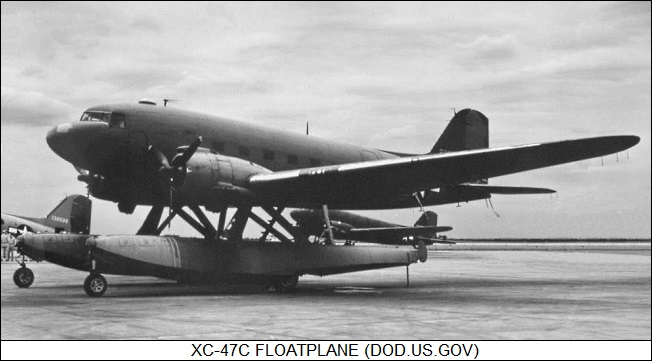
The single XCG-17 was modified from a stock C-47 to meet a requirement for a heavy cargo glider. Early tests were performed on a C-47 performing "deadstick" landings, with the engines then pulled out and the nacelles faired over. The nacelles were not removed, since the USAAF wanted to be able to reconvert the gliders back into powered C-47s if the need arose. The XCG-17 had an excellent glide ratio, a tribute to the DC-3's clean design, but the USAAF did not go ahead with the concept.
* About 600 C-47s and C-53s from the total production were obtained by the US Navy and Marine Corps under the designation "R4D", with variant designations as follows:
The Navy and Marine Corps also flew a number of specialized modifications of stock C-47s and C-53s:
The histories of these variants are obscure and some of them, like the R4D-6Q, which was liberally decorated with antenna fairings, were clearly postwar conversions.
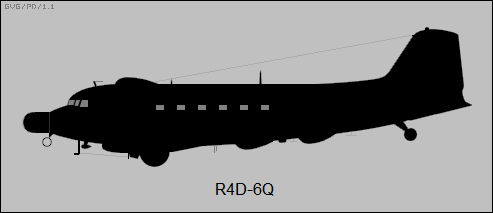
* The British were particularly enthusiastic users of the DC-3 and its variants. A few commercial DC-2s and DC-3s were purchased or pressed into military service early in the war, and eventually were given the name "Dakota". This eventually became, more or less, the accepted name for all military DC-3 versions, though the US name of "Gooney Bird" was a strong competitor.
The British eventually received over 1,900 more Dakotas from total production through Lend-Lease, including:
Roughly 200 Dakotas of various types were passed on to the Royal Canadian Air Force (RCAF), which put them to good use. Over 700 Dakotas were also supplied to the Soviet Union during the conflict. The different versions of the DC-3 in Allied military service are generally referred to as "C-47s" in the rest of this document, though as the discussion in this section shows, that is an oversimplification.
BACK_TO_TOP* The C-47 was put to use by US armed forces immediately on America's entry to the war. The Naval Air Transport Service was established just a few days after Pearl Harbor, and would make extensive use of the type. The USAAF Air Transport Command was formed in the middle of 1941, and also proved an enthusiastic user.
The C-47's most prominent claim to fame in World War II combat was in support of airborne assaults, mostly under the umbrella of the USAAF Troop Carrier Command and the British Royal Air Force (RAF) Transport Command. The RAF Transport Command found them far superior for parachute assaults than the hand-me-down Whitley bombers and other obsolescent aircraft they had been using as stopgaps. 59 Dakotas were also supplied to the British Overseas Airways Corporation (BOAC) to service regular transport routes.
Although the British dropped a brigade of paratroops into North Africa with the Dakota in November 1942, the C-47's first large-scale introduction to combat was in July 1943, when Dakotas dropped about 4,000 paratroopers and glider troops in support of the Allied invasion of Sicily. This was followed by the massive airdrops in support of the Allied invasion of Normandy in June 1944, with 1,000 C-47s providing the backbone of the airlift capacity and delivering 60,000 paratroops and equipment in 60 hours.
The C-47 was used extensively in Burma, with the aircraft providing supply for Orde Wingate's Chindit commandos operating behind enemy lines during the winter of 1942:1943. Other C-47s flew the Hump from India to China and back, carrying a total of 590,000 tonnes (650,000 tons) of supplies in all. These flights were often difficult due to severe winds, weather, and deep cold temperatures, not to mention enemy action. During one of these flights, a C-47 was attacked by a Japanese Nakajima Ki-43 fighter. The lightly armed Ki-43 was not able to fatally damage the sturdy C-47, and either in clumsiness or suicidal determination the fighter actually rammed the transport. The Oscar lost a wing and fell to earth. The C-47, with a great hole torn in its roof, returned to base.
Even when severely damaged, a C-47 could make a relatively safe wheels-up landing, because its main gear did not fully retract and took up some of the load. The tailwheel configuration of the aircraft was also an advantage for rough-field operation, since having the aircraft's center of gravity behind the main wheels meant that the C-47 had less of a tendency to pitch forward when riding over obstructions, and also kept the engines and cockpit riding high above dust and debris.
As the war tilted increasingly against the Axis, the C-47 was in the front lines. In addition to relatively small airdrops in Italy, Greece, and the Philippines, the C-47 also conducted large airdrops during the invasion of southern France in August 1944; the assault on Arnhem in the Netherlands in September 1944, where Dakota pilots distinguished themselves in determined attempts to resupply surrounded British paratroops in the face of severe enemy anti-aircraft fire; during the Rhine crossing in March 1945; and in offensive operations in Burma in March and May 1945.
* Although airborne assault was the C-47's greatest claim to fame, it was an excellent "flying truck" and performed almost every imaginable transport task, from ferrying critical cargoes, evacuating wounded, dropping supplies to resistance groups, and even ferrying a V-1 jet flying bomb back from Poland. A number of Dakotas were unsurprisingly used as VIP transports, in a few recorded cases transporting the British Royal family, and both General Dwight Eisenhower and British Field Marshal Sir Bernard Montgomery used the Dakota as their personal transport.
Some uses of the aircraft were imaginative. In June 1943, an RAF Dakota Mark I towed a Waco transport glider over the Atlantic as a means of increasing transatlantic cargo lift capacity. The experiment was a success, but there was no follow-up to the concept. Allied forces in also developed procedures where a C-47 could "hook" an empty glider from a drop zone, and return it to base for re-use.
BACK_TO_TOP* A total of 10,926 DC-3s and C-47s was built up to the end of the war, the vast bulk of them being C-47s. Unlike many aircraft used in World War II, the C-47 did not go into rapid decline at the end of the war. It was not a victim of the mad scramble to scrap aircraft that reduced the numbers of other famous aircraft of the war from thousands to handfuls, since the C-47 was just too useful. It was overbuilt, making it almost indestructible. As one Dakota pilot put it: "You can wreck a Dak, but you can't wear it out."
In fact, Douglas hoped to build and sell more DC-3s in the postwar period, and in 1947 produced two examples of the "Super DC-3", also known as the "DC-35". These two aircraft were conversions from older DC-3s, and featured fully retractable main gear, a longer fuselage with an improved interior fit for 30 passengers, a taller tailfin, and distinctive squared-off wingtips. The first Super DC-3 was fitted with Wright R-1820-C9HE Cyclones with 1,100 kW (1,475 HP) each, while the second was fitted with P&W R-2000-D7 Twin Wasp 14-cylinder two-row air-cooled radials with 1,080 kW (1,450 HP) each.
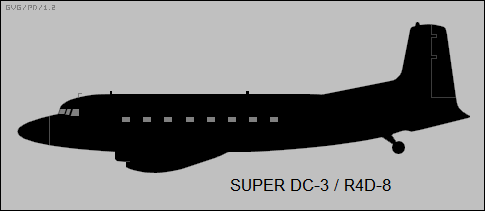
First flight of the Super DC-3 was in June 1949. However, the DC-3 was no longer the best aircraft available to the airlines, and only three Super DC-3s went into commercial service. The US Air Force (USAF), which was formed in 1947 when the USAAF became an independent service, acquired the first prototype, but passed it on to the US Navy, which had 100 R4Ds updated to Super DC-3 standard. The Navy designated the type the "R4D-8", though it appears to also have been known by its USAF designation, "C-117D".
* The C-47 remained in first-line service with too many air forces to list into the 1950s, and was a prominent contributor to the Berlin Airlift in 1948 and 1949. The French used them during the first Indochina War, and also used one as a flying command post during the Anglo-French-Israeli Suez intervention in 1956. One interesting use from the 1960s involved various Dakotas fitted with the nose of a Lockheed F-104 Starfighter containing the Starfighter's sophisticated NASARR radar, being used for trials and training. At least one was operated by the Canadians, who of course nicknamed theirs "Pinocchio". Five were known to have been operated by the Luftwaffe, being nicknamed "Nasenbaer", a play on NASARR meaning "Nosy Bear" AKA coati mundi.

As mentioned, many of the specialized Navy variants were postwar conversions, with some serving well into the 1960s. The USAF operated a large number of modifications, including the "VC-47A", "VC-47B", and "VC-47D" staff transport conversions; the "RC-47A" and "RC-47D", described as "reconnaissance" machines and apparently used for battlefield spotting and flare dropping during the Korean War; and the "SC-47A" and "SC-47D" search and rescue aircraft, redesignated "HC-47A" and "HC-47D" in 1962.
The C-47 had a very lively career in the Vietnam War. As an excellent "bush" aircraft, it was of course used to fly cargoes into the backwoods of Laos in support of anti-Communist tribes working with the Americans, but it was also used for both electronic intelligence (ELINT) and as a gunship.
The ELINT C-47s were designated "EC-47" and were known as "Electric Goons" by their crews, following the old "Gooney Bird" name for the C-47. They were equipped with signals intercept and emitter location gear, and were used to target enemy radio transmissions.
A few C-47s were converted to ELINT configurations in the early 1960s, with these machines performing some service in Vietnam. By 1966, the Army was operating their own fleet of ELINT aircraft over Vietnam -- but didn't have enough of them, and the C-47 was felt to be more capable than the Army aircraft. In response, the Air Force instituted a crash program to convert C-47s to the EC-47 configuration, with the first reaching service in the spring of 1966. Roughly 50 EC-47s were obtained in all.
There were several variations on the Electric Goons, subtly differing in electronic gear fit, including the "EC-47N", "EC-47P", and "EC-47Q". They saw plenty of combat, in particular serving with distinction in helping to call in strikes during the siege of Khe Sanh in early 1968, and several were lost in action. The EC-47s were phased out of service with the gradual disengagement of the US from the conflict in the early 1970s.
* The electronic mission conversions of the Dakota are very obscure, but another C-47 conversion of the war, the "AC-47D" gunship, became one of the most famous variants of the series.
Late in World War II, an Army Air Forces lieutenant named Gilmour C. MacDonald had come up with the idea of mounting side-firing weapons in aircraft for the ground attack mission. The pilot of a conventional attack aircraft had to make a pass on a target and fire his weapons, then come around for another pass. The pilot of an attack aircraft with side-firing weapons could simply perform a banking "pylon turn" around a target, line up the target along his wingtip, and then hose it down with a "cone of fire" for as long as ammunition held out.
Nothing came of the idea until 1961, when MacDonald, by then a USAF lieutenant colonel, brought it up again and managed to inspire a set of shoestring demonstrations of the concept. By 1964, it was the right idea in the right place. The USAF was trying to come to grips with the difficulties of fighting the growing jungle war in Southeast Asia, in particular casting about for a way to perform effective close air support for ground operations. In August of that year, the war had undergone a drastic escalation with the Tonkin Gulf incident. In November, a USAF captain named Ronald W. Terry sold the idea of a gunship to the brass, and was authorized to put together two gunships quickly for a combat evaluation. MacDonald was the father of the idea of the side-firing gunship, but Terry was the one who would make it work.
The initial two Dakota gunships were in country by December and in combat before the end of the year. The gunships were originally given the designation of "FC-47D", but this was quickly changed to "AC-47D" in response to loud complaints by fighter pilots that calling any kind of a C-47 a "fighter" was really stretching the definition of the term.
The AC-47Ds was fitted with three 7.62-millimeter (0.30-caliber) Gatling-style Miniguns firing out the left side of the aircraft. The Miniguns had a selectable rate of fire of 3,000 or 6,000 rounds per minute, and the gunship typically carried about 24,000 rounds of ammunition. Early gunships used improvised cargo-hold mounts for standard SUU-11A/A Minigun pods, the pod having been designed as an underwing store. Later gunships carried GAU-2B/A Miniguns more specifically rigged for the task, and then the far more satisfactory MXU-470/A Miniguns, which used an ammunition drum instead of a belt-feed from ammunition cans, with great improvement in convenience and reliability. After some experience, the guns would be fixed pointing 12 degrees downward, reducing the aircraft bank angle required for attacks.
Ballistic armor curtains were fitted to the left side of the aircraft to protect crew and systems; new radio and navigation equipment were installed; a Mark 20 gunsight salvaged from the Douglas A-1 Skyraider attack aircraft was fitted to the cockpit left-side window; and a trigger button from the same source was attached to the pilot's control wheel. The AC-47Ds also carried a bin of illumination flares for night fighting next to the cargo door, with the flares tossed out of the aircraft by the flight crew by hand. The bin was later armored to prevent the flares from being set off by ground fire.
Vietnamese who observed attacks by the gunships compared them to roaring, fire-spouting dragons, and so the gunships acquired the name "Puff", after a contemporary pop tune, "Puff the Magic Dragon". They were more informally called "Spooky" after their radio callsign, and were well-liked by US ground forces for their ability to literally rip enemy assaults to shreds.
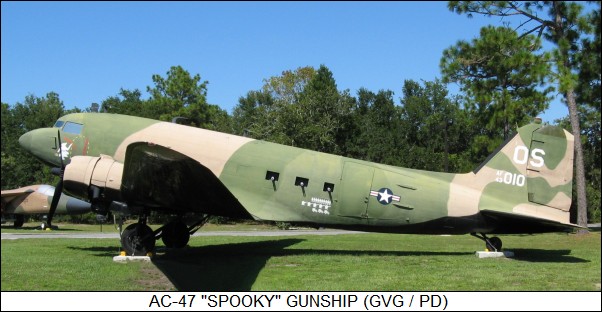
Demand for the Spooky was so high that availability of Miniguns became a problem, so four of the AC-47Ds were put together using a stockpile of old Browning 7.62-millimeter machine guns found in a warehouse in California, with each aircraft carrying ten side-firing machine guns each.
About 47 AC-47Ds were produced, with 12 lost in combat, particularly as enemy air defenses improved. A more capable platform -- in particular equipped with an advanced sensor system to permit it to perform "search and destroy" missions, instead of simply performing fire support -- was obviously needed. The AC-47Ds were replaced by the Fairchild AC-119G Boxcar gunship, with an electronic sensor system, for fire support missions, with the search and destroy mission farmed out to the highly sophisticated, better-armed, and completely fearsome Lockheed AC-130A Hercules / Spectre gunship.
That was not the end of the AC-47, however. In 1987, the Colombian government obtained the first two of four AC-47 conversions, each armed with three side-firing Browning 12.7-millimeter (0.50-caliber) machine guns, and a cockpit sight obtained from a Lockheed T-33. They were given the name "Fantasma (Phantom)", presumably in inspiration of the old "Spooky" name. One was lost in an accident.
The Fantasmas proved effective, but had limitations -- one big problem being their age, the old radials being cantankerous to keep working, and not powerful enough to handle operations in high terrain; and also the fact that the only night-fighting capability they had was via parachute flares. That led to a substantial rethinking of the concept, as discussed later.
BACK_TO_TOP* Although numbers of Dakotas in military service have continuously declined since World War II, they still remain in operation in many countries, particularly in Latin America. The Dakota remains in commercial service because it is cheap to buy and operate, and there are ample supplies of parts to keep it in the air. The major problem is that the R-1830 Twin Wasp engines are at the end of their lifetimes. As a result, there is an active trade in re-engining old Dakotas, invariably to turboprop operation.
The earliest turboprop conversion was done by Armstrong Siddeley in 1949 to flight-test Mamba turboprop engines, though the aircraft was eventually refitted with Twin Wasps and sold off. Rolls-Royce similarly refitted a Dakota with Dart turboprops in 1950. These were strictly engine test fits and not intended for production. However, in recent decades several different types of "Turbo Dakotas" have seen operational service.
One the companies to perform turboprop conversions of the DC-3 the US Conroy company, starting with a conversion of a DC-3 with twin Rolls-Royce Dart Mk.510 turboprops, providing 1,195 kW (1,600 HP) each and driving four-bladed props, flying for the first time in that configuration in 1969. This "Turbo-3" was followed by a similar conversion of a Super DC-3, with this "Super Turbo-3" flying a few years later. Nothing much was done with either of them.
They were followed by the "Tri Turbo-3", which was fitted with three Pratt & Whitney Canada PT6A-45 turboprops with 876 kW (1,174 SHP) each, performing its first flight in 1977. Two of the turboprops replaced the radial engines, while the third was fitted in the nose. After its cockpit was set on fire during servicing, the wings and tail were transplanted to another DC-3. Although it had an excess of power and good short-field characteristics, the nose engine installation was something of a "kluge", and there was leakage of engine exhaust into the cockpit, at least early on. The Tri Turbo did put in good field service.
Modern Turbo Dakotas use twin engines, generally some version of the popular PT6A. Basler Corporation of Oshkosh, Wisconsin, has been particularly successful with their "BT-67 Turbo Dakota", which the company initially flew in 1990. Basler buys old Dakotas in good condition for a few hundred thousand dollars; "zero-lifes" the airframe by replacing worn components and adding reinforcements; replaces the R-1830s with PT6A-67R turboprops driving five-bladed Hartzell propellers; and in general modernizes the aircraft.
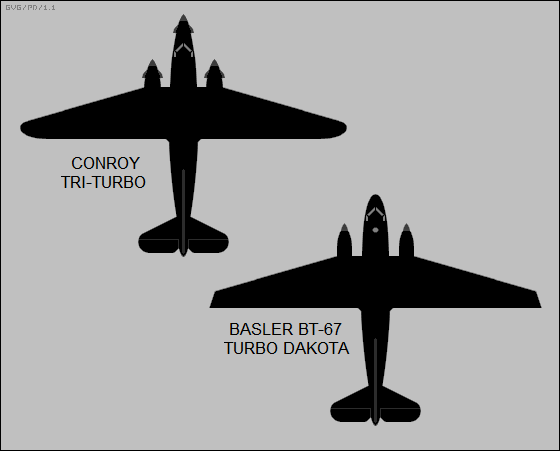
The modernizations include adding a 1-meter (40-inch) fuselage plug and eliminating the unnecessary radio operator's compartment so that the cargo bulkhead can be moved forward, giving the BT-67 35% more internal volume. The radio operator is no longer required because a BT-67 has up-to-date avionics, as well as new electrical, hydraulic, and fuel systems. The wings are modified to give them improved low-speed capabilities and a "squared-off" appearance.
A BT-67 can carry 1,800 kilograms (4,000 pounds) more cargo than a DC-3, and increases the cruise speed by 72 KPH (45 MPH), while reducing approach speed. A bright shiny "new" BT-67 costs about $4 million USD. The Colombian Air Force, having recognized the limitations of their AC-47 Fantasma gunships, decided to update the concept by bringing them up to BT-67 standards, giving them the designation of "AC-47T". These machines were fitted with a Star SAFIRE forward looking infra-red (FLIR) imaging turret under the nose.
The AC-47Ts proved a big advance over the original Fantasmas -- the turboprop engines made them deadly quiet in night attacks. They originally retained the triple Brownings, but they were replaced by twin GAU-19 / GECAL three-barreled 12.7-millimeter Gatling guns. The cockpits were also refitted with lighting compatible with night-vision goggles (NVG), and flares only visible under NVG were carried as well. The old night-illumination flares were retained, simply because they intimidated insurgents.
There were 8 conversions, two having been lost in accidents. Aircraft in service have been enhanced, improvements including chaff-flare dispensers, a day-night electro-optic / infrared (EO-IR) imaging turret, GPS navigation, satellite communications, and replacement of one of the GECAL Gatling guns with a GIAT M621 20-millimeter cannon, for use against fortified targets.
BT-67s are used all over the world, with the aircraft flown in Thailand to seed clouds and by the US Forest Service in America to drop smoke jumpers. By the way, Basler now owns the Conroy Tri-Turbo and hopes to eventually recondition it as an important landmark in the Dakota's history.

The South African Air Force (SAAF) obtained at least 30 "C-47TP Turbodak" conversions, performed by AMI of Forth Worth, Texas. They had PT6A-65AR turboprops with 920 skW (1,230 SHP) driving 5-bladed Hartzell propellers, a 1.02-meter (3 foot 4 inch) fuselage stretch forward of the wing, a new electrical system, modernized avionics including a radar, and other general improvements. The SAAF used their Turbodaks for everything from VIP transport to electronic intelligence and maritime patrol. They finally wore out, being grounded as unsafe to fly in 2022, and fully retired in 2024.
BACK_TO_TOP